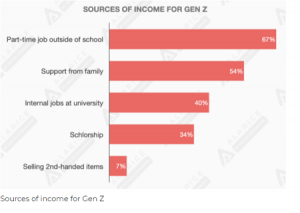(PRESS RELEASE) Covid-19 created an economic downturn that ultimately exposed the weaknesses of some retail brands in China. It also brought opportunity for brands to explore new avenues of retail storytelling and create a stronger digital presence. It’s important for luxury brands to understand the changing ecosystem in China and how they can adapt their strategy to stay stable in China’s market in the long run.
Throughout 2020, many brands in the luxury sector experienced significant growth in China. In fact, the luxury sector had a consistent level of growth compared to other global markets. This is something that is expected to continue over the next decade. Spending power of GenZ consumers accounted for more than 40% of the luxury sector (Chozan, Statista). This spending power is due to half of all consumers in this age category holding a university degree and strong confidence for the future, enabling them to spend a large portion of their monthly income. Though, Covid may have shaken their confidence, they still hold a strong presence in the luxury sector.
Understanding how to connect with these consumers can be a challenge for some brands. When looking at China’s market, it should be understood that Chinese consumers are different from Western consumers. Their understanding of a brand and its products goes deeper. They look at the whole picture to understand a brand and highly value the story behind a brand and its products. If the consumer does not feel a connection to the brand they will not buy its products.
One of the biggest shifts in China over the past year is mainly due to a stronger focus in domestic spending. With strict requirements for exit and entry, international travel is not an option for most consumers. Due to this, local tourism and travel saw a boost throughout the second half of 2020 as the number of cases continued to stay at a very low number. Destinations like Sanya, in Hainan province saw a huge uptake in domestic travel. Special administrative duty-free shopping zones enabled consumers to buy luxury goods at tax exempt prices. This led to an overall increase of more than 90% in luxury consumption in Sanya since October 2020 (Bain & Company).
While the world continues to wait for things to go back to ‘normal’ or pre-covid shopping habits, it’s important for brands to make the changes needed to be successful in China’s market. As it’s been written many times before, brands need an omni-channel strategy, and more importantly at the present, a strong overall digital strategy. There are four key points that are important to building an effective digital strategy for Chinese consumers.
- Brand Storytelling
- Consumer Engagement
- Relevant Content
- KOL Strategy
The most important factor that will help bring brands success in their digital strategy is adaptability. Trends can come and go quite quickly, therefore, it is extremely important to find a strategy that can be adapted easily and fast. Having a strategy that enables the brand to have real time brand and ROI management is important for being able to adapt. As for the other basics, a well researched plan and a clear understanding of target consumers and their characteristics is an important factor in building this plan.
Advertisement
In order to integrate online channels into a strong overall digital strategy, it is also important to connect these strategic points to the physical retail store. Consumers want experience, they want to feel unique and stand out in a mass market, and they want it to feel personal to them. There are four key ways to achieve this in retail design.
- Digital integration points that connect to online channels
- Pop-up stores
- Customizable products in stores
- Storytelling elements
Omnichannel shopping is shifting retail strategy in China. A study by McKinsey in 2019 showed that 85% of consumers utilized both online and offline channels to purchase from a brand. Making further adjustments to adapt the overall strategy quickly is an important factor for creating long-term stability and success in China’s market.
PHOTO GALLERY (4 IMAGES)
SUBMITTING PRESS RELEASES Send your press releases to VMSD at press@vmsd.com. Learn about our submission guidelines.

 Special Reports3 days ago
Special Reports3 days ago
 Headlines2 weeks ago
Headlines2 weeks ago
 Headlines1 week ago
Headlines1 week ago
 Headlines2 weeks ago
Headlines2 weeks ago
 Headlines1 week ago
Headlines1 week ago
 Eric Feigenbaum4 days ago
Eric Feigenbaum4 days ago
 Headlines3 days ago
Headlines3 days ago
 NXTLVL Experience Design1 week ago
NXTLVL Experience Design1 week ago
















